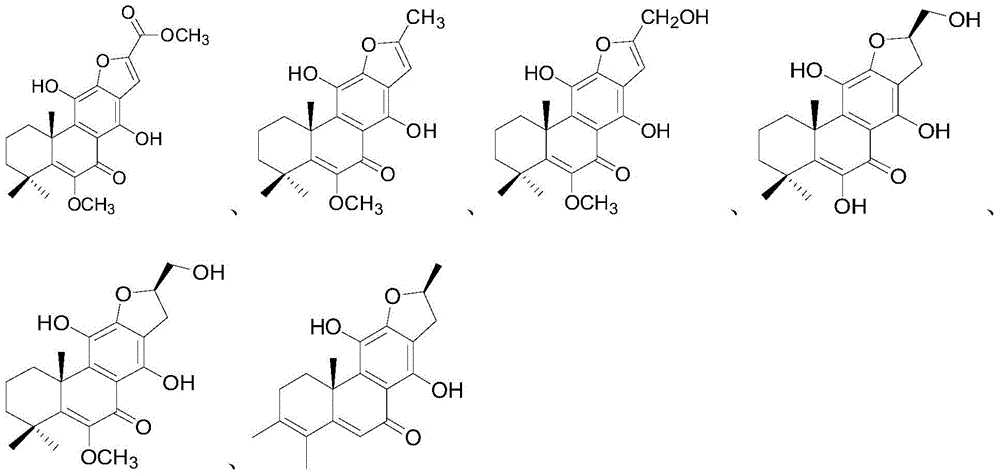Rosin type diterpene derivative and its preparation method and application
A technology of derivatives and diterpenes, applied in the field of rosin-type diterpene derivatives and their preparation
- Summary
- Abstract
- Description
- Claims
- Application Information
AI Technical Summary
Problems solved by technology
Method used
Image
Examples
Embodiment 1
[0026] Take 1 kg of stinky peony root, crush it and add it to 3L of ethanol with a volume fraction of 95% for reflux extraction, reflux extraction twice, each time for 2 hours, filter and combine the extracts, recover the ethanol under reduced pressure, and suspend the extract in water , extract the suspension with petroleum ether (60-90°C) for 5 times, combine the petroleum ether layers and recover the solvent under reduced pressure to obtain petroleum ether fractions; pass the obtained petroleum ether fractions through silica gel column chromatography, and use a volume ratio of 20 :1, 10:1, 8.5:1.5, 7:3 and 1:1 mixture of petroleum ether and ethyl acetate for gradient elution, TLC inspection, segmented collection, and 5 parts (Fr. 1~Fr.5), wherein, Fr.2 and Fr.4 were firstly subjected to Sephadex LH-20 column chromatography, eluted with a mixture of dichloromethane and methanol at a volume ratio of 1:1, and then passed through a silica gel column Chromatography, using a mixt...
Embodiment 2
[0029] Take 2kg of the whole plant of Smelly Peony, crush it, add 6L ethanol with a volume fraction of 95% for ultrasonic extraction, extract 3 times, each time for 30 minutes, filter and combine the extracts, recover the ethanol under reduced pressure, and suspend the extract in water; Extract the suspension with petroleum ether (60-90°C) for 5 times, combine the petroleum ether layers and recover the solvent under reduced pressure to obtain petroleum ether fractions; pass the obtained petroleum ether fractions through silica gel column chromatography, and sequentially use a volume ratio of 20:1 , 10:1, 8:2, and 1:1 mixture of petroleum ether and ethyl acetate for gradient elution, thin-layer chromatography inspection, segmental collection of diterpene-containing fractions to obtain 4 parts (Fr .1~Fr.4); Among them, Fr.2 and Fr.3 were firstly subjected to Sephadex LH-20 column chromatography, eluted with a mixture of dichloromethane and methanol at a volume ratio of 1:1, and t...
Embodiment 3
[0052] The sterol regulatory element binding protein (SREBP) signal transduction pathway is one of the main pathways of lipid metabolism signal transduction. As a powerful activator, SREBP can directly activate more than 30 pathways involved in the synthesis and uptake of fatty acids, triglycerides and phospholipids. gene expression. Therefore, inhibiting the expression of SREBP can achieve the purpose of lowering blood lipids. In the present invention, the inhibitory effect of compounds 1-6 on SREBP expression is tested to reflect its lipid-lowering efficacy.
[0053] The pSRE-Luciferase plasmid and pEGFP-N1 plasmid (Invitrogen) were transferred into Huh-7 cell line at a ratio of 5:1 to obtain Huh-7 / SRE-Luc cell line. Huh-7 / SRE-Luc cells in good growth condition were taken for experiments, and the cell concentration was adjusted to about 10000 / well. Liquid was added to the 96 wells with a pipette, and 200 μL of cell solution was injected into each well for cell culture for ...
PUM
 Login to View More
Login to View More Abstract
Description
Claims
Application Information
 Login to View More
Login to View More - R&D
- Intellectual Property
- Life Sciences
- Materials
- Tech Scout
- Unparalleled Data Quality
- Higher Quality Content
- 60% Fewer Hallucinations
Browse by: Latest US Patents, China's latest patents, Technical Efficacy Thesaurus, Application Domain, Technology Topic, Popular Technical Reports.
© 2025 PatSnap. All rights reserved.Legal|Privacy policy|Modern Slavery Act Transparency Statement|Sitemap|About US| Contact US: help@patsnap.com



